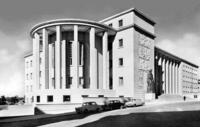State Modernism: Difference between revisions
(Created page with "{{sidebar|image={{Photomontage | photo2a = state modernism 1.png | photo2b = state modernism 2.png | photo3a = state modernism 3.png | photo3b = state modernism 4.png | size =...") |
No edit summary |
||
| (4 intermediate revisions by 2 users not shown) | |||
| Line 1: | Line 1: | ||
{{ | {{image frame|content={{Photomontage | ||
| | | photo1a = state modernism 3.png | ||
| | | photo2a = state modernism 2.png | ||
| | | photo4a = state modernism 4.png | ||
| color = transparent | | color = transparent | ||
| border = 0 | | border = 0 | ||
| | }} | ||
| | | width = 202 | ||
| caption = <small>From top to bottom: Emperor Michael Convention Centre ([[Thrace]]); National Museum of Modern Art ([[Ichoria]]); Kavale Superior Court ([[Kathia]])</small> | |||
}} | |||
'''State Modernism''' is an {{wp|architectural style}} which originated in [[Aurora (continent)|Aurora]] and the [[Veharia|New World]] in the late 15th Century [[Elyrian calendar|<small>AC</small>]] and which primarily deals with governmental, judicial, or other kinds of public buildings. | '''State Modernism''' is an {{wp|architectural style}} which originated in [[Aurora (continent)|Aurora]] and the [[Veharia|New World]] in the late 15th Century [[Elyrian calendar|<small>AC</small>]] and which primarily deals with governmental, judicial, or other kinds of public buildings. | ||
An offshoot of {{wp|modernist architecture}}, state modernism has been described as a synthesis of {{wp|neoclassical architecture|neoclassical}} formal elements with a modernist ethos. Facades are often characterized by {{wp|colonnade|colonnades}} and bare or engraved {{wp|architrave|epistyles}}, but complex elements such as {{wp|capital (architecture)|capitals}} and triangular {{wp|pediment|pediments}} are eschewed in favor of simplicity of design. Flat roofs reinforce a sense of horizontal extension while columns, rectangular or cylindrical in shape, emphasize verticality – in short, as with [[Ancient Elyria|Classical Elyrian]] architecture, aesthetic monumentality reinforces {{wp|State (polity)|state}} authority. | An offshoot of {{wp|modernist architecture}}, state modernism has been described as a synthesis of {{wp|neoclassical architecture|neoclassical}} formal elements with a modernist ethos. Facades are often characterized by {{wp|colonnade|colonnades}} and bare or engraved {{wp|architrave|epistyles}}, but complex elements such as {{wp|capital (architecture)|capitals}} and triangular {{wp|pediment|pediments}} are eschewed in favor of simplicity of design. Flat roofs reinforce a sense of horizontal extension while columns, rectangular or cylindrical in shape, emphasize verticality – in short, as with [[Ancient Elyria|Classical Elyrian]] architecture, aesthetic monumentality reinforces {{wp|State (polity)|state}} authority. | ||
{{Template:INWU}} | |||
[[Category:INWU]] | |||
Latest revision as of 18:13, 4 December 2019
State Modernism is an architectural style which originated in Aurora and the New World in the late 15th Century AC and which primarily deals with governmental, judicial, or other kinds of public buildings.
An offshoot of modernist architecture, state modernism has been described as a synthesis of neoclassical formal elements with a modernist ethos. Facades are often characterized by colonnades and bare or engraved epistyles, but complex elements such as capitals and triangular pediments are eschewed in favor of simplicity of design. Flat roofs reinforce a sense of horizontal extension while columns, rectangular or cylindrical in shape, emphasize verticality – in short, as with Classical Elyrian architecture, aesthetic monumentality reinforces state authority.



